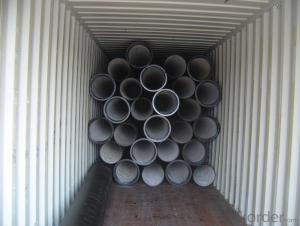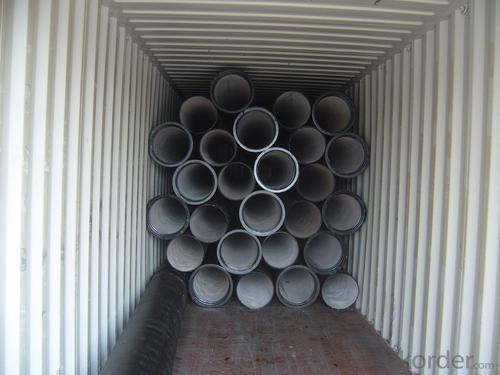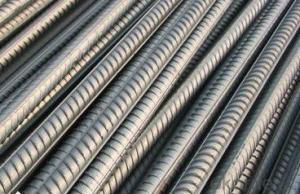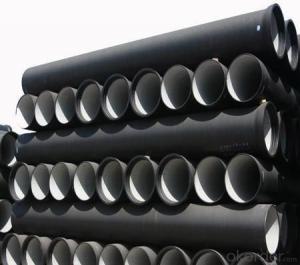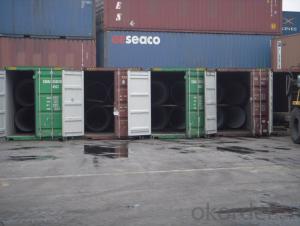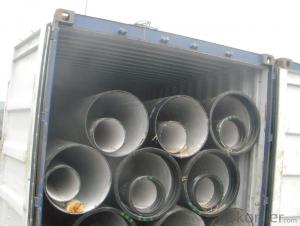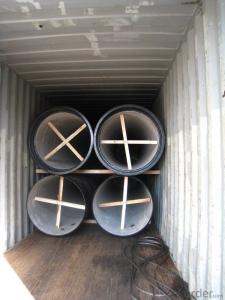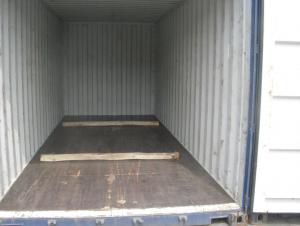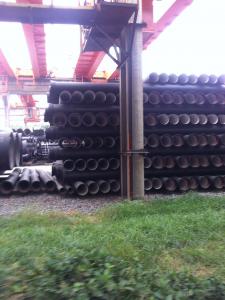DUCTILE IRON PIPE AND PIPE FITTINGS CCLASS DN1500
- Loading Port:
- Tianjin
- Payment Terms:
- TT OR LC
- Min Order Qty:
- 23 pc
- Supply Capability:
- 3000 pc/month
OKorder Service Pledge
OKorder Financial Service
You Might Also Like
· Material : Ductile Cast Iron
· Size Range : DN 80mm to DN 2000mm
· Unit Effective Length : 6m or 5.7m
· Manufacture Standard: ISO 2531:1998/ EN 545:2006/EN 598:2007
· Annual capacity : 200,000 tons
· Coating Exterior: Zinc 130g/m2 according to ISO 8179-1 and bitumen coating 70 microns.
· Cement Interior: Portland Cement/ High Alumina Cement/ Sulphate Resisting Cement Lining according to ISO 4179
· Special requirements on external coating and internal lining can be applied
· We also provide accessories such as SBR/EPDM rubber gaskets, lubricant paste, pipe caps, PE sleeves, etc.
Additional Parts:
Each pipe is strictly inspected according to related standard to ensure permanently high performance.
Easy Installation at site and service free for life
Long Service Lifespan
Quotation will arrive you within 24hours once we get your inquiry.
We guarantee offering you a competitive price.
A copy of original inspection reports of pipes will be offered after shipment.
Photos of loading process will be sent to the customer after shipment effect.
We will follow-up the delivery progress after shipment effect and update to the customer on weekly basis.
- Q: Can ductile iron pipes be used in potable water systems?
- Ductile iron pipes are indeed suitable for use in potable water systems. They belong to the cast iron category but possess increased strength and ductility. Their durability, resistance to corrosion, and long lifespan make them a popular choice for water infrastructure, especially potable water systems. These pipes are produced in accordance with specific standards and regulations governing the use of potable water, ensuring the safe transportation of drinking water. Moreover, ductile iron pipes exhibit exceptional flow characteristics, making them well-suited for water distribution systems. All in all, ductile iron pipes are a dependable and frequently employed material in potable water systems.
- Q: Can ductile iron pipe be repaired if it gets damaged?
- If ductile iron pipe sustains damage, it can indeed be repaired. The process of repair entails the removal of the damaged section and the subsequent substitution with a fresh section. Typically, a pipe cutter, a specialized tool, is utilized to achieve a seamless cut on both ends of the affected area. Once the damaged portion is extracted, a new section of ductile iron pipe is affixed securely by employing mechanical couplings or welding. To safeguard the pipe's integrity and functionality, it is crucial to adhere to the manufacturer's guidelines and industry standards during the repair procedure.
- Q: What are the requirements for the hydrostatic test of ductile iron pipes?
- The pipe work pressure P is less than 0.5MPa, the test pressure is 2P, the pipe work pressure is greater than 0.5MPa, the test pressure is P+0.5. After the water pressure rises to the test pressure, the pressure is fixed for 10 minutes, and the pipe joint and the pipe body are not damaged and leaked.
- Q: What is the average weight of ductile iron pipes?
- The weight of ductile iron pipes can differ based on their specific dimensions and specifications. However, as a general rule, the weight of ductile iron pipes usually falls within the range of 50 to 200 pounds per foot. Various factors, including the pipe's diameter, wall thickness, and length, affect its weight. It is essential to understand that these weights are averages, and the actual weight of a particular ductile iron pipe may differ. To accurately determine the weight of a ductile iron pipe, it is recommended to consult the manufacturer's specifications or engineering guidelines.
- Q: Are ductile iron pipes suitable for use in wastewater pumping stations?
- Yes, ductile iron pipes are suitable for use in wastewater pumping stations. Ductile iron is a strong and durable material that can withstand the harsh conditions and corrosive nature of wastewater. It has excellent resistance to corrosion and can handle high-pressure environments, making it an ideal choice for transporting wastewater in pumping stations. Additionally, ductile iron pipes have a long lifespan and require minimal maintenance, reducing the overall cost of operation and ensuring reliable and efficient wastewater transportation.
- Q: What is the disadvantage of nodular cast iron in excess of silicon?
- Excessive silicon control results in the formation of nodular graphite in large cross section ductile iron and reduces the mechanical properties of castings.
- Q: What is the expected sound attenuation of ductile iron pipes?
- The expected sound attenuation of ductile iron pipes can vary depending on several factors. Generally, ductile iron pipes have good sound attenuation properties due to their dense and thick-walled construction. The material's density helps to absorb and dampen sound waves, reducing the transmission of noise. Additionally, the thickness of the pipe walls also contributes to sound attenuation by providing an extra barrier for sound to pass through. However, it is important to note that the specific sound attenuation of ductile iron pipes can be influenced by other factors such as pipe diameter, wall thickness, installation method, and surrounding environment. For example, larger diameter pipes may have slightly lower sound attenuation compared to smaller diameter pipes due to increased surface area. Similarly, variations in wall thickness can affect the sound insulation properties. In terms of installation, the presence of joints or fittings in the pipeline can potentially create sound transmission points, reducing sound attenuation. Therefore, proper installation techniques that minimize the use of joints and fittings can help enhance sound attenuation. Furthermore, the surrounding environment can also impact sound attenuation. For instance, if the pipes are buried in soil, the soil's composition and density can affect the sound transmission properties. Additionally, the presence of other structures or materials in the vicinity may influence the overall sound attenuation performance. To determine the specific expected sound attenuation of ductile iron pipes for a particular application, it is recommended to consult manufacturer specifications or seek assistance from acoustic engineering professionals who can take into account all relevant factors and conduct specific tests or simulations to provide accurate predictions.
- Q: How are ductile iron pipes tested for hydrostatic pressure?
- For water and wastewater applications, ductile iron pipes are widely used because of their strength and durability. To guarantee their quality and dependability, these pipes undergo hydrostatic pressure testing. The process of hydrostatic pressure testing involves applying internal pressure on the ductile iron pipes at levels higher than their normal operating pressure. This is done to evaluate their ability to withstand the maximum pressure they may encounter during their service life. To begin the testing, a sample set of pipes is carefully selected from a production batch or shipment. These samples are meticulously prepared by removing any surface coatings or debris that could affect the accuracy of the test results. The prepared samples are then placed in a specially designed test rig or test line. The test rig is equipped with all the necessary connections, valves, and gauges to accurately control and monitor the test conditions. Once the samples are secured in the test rig, water or another suitable test fluid is slowly introduced into the pipes. The pressure is gradually increased to a preset level, typically surpassing the expected operating pressure by a certain factor. This elevated pressure is maintained for a specified duration, usually several hours, to evaluate the structural integrity and leak resistance of the pipes. Throughout the test, the pipes are closely monitored for any signs of leakage, deformation, or failure. Skilled technicians or engineers observe the pressure gauges and visually inspect the pipes for any visible defects or abnormalities. Additionally, automated systems may be used to continuously record and analyze the pressure readings, ensuring accurate data collection. After the specified test duration, the pressure is gradually released, and the pipes are meticulously inspected for any permanent deformation or residual stress. This inspection may involve visual examination, dimensional measurements, or non-destructive testing techniques like ultrasonic testing or magnetic particle inspection. The test results are then assessed against the relevant industry standards or specifications to determine if the pipes comply with safety and performance requirements. If the pipes pass the hydrostatic pressure test, they are considered suitable for their intended application. However, if any issues or failures are identified, further investigation, analysis, or corrective actions may be necessary before the pipes can be approved for use. In conclusion, hydrostatic pressure testing plays a vital role in ensuring the quality and reliability of ductile iron pipes. By subjecting these pipes to rigorous testing procedures, manufacturers can provide customers with pipes that meet the highest standards of safety and performance.
- Q: If the ductile iron pipe is broken, can we use rush repair?
- In this way, manpower, material resources and financial resources can be saved, time can be saved, and unnecessary troubles to the citizens' water supply can also be reduced.
- Q: How is ductile iron pipe protected against external corrosion?
- Ductile iron pipe is protected against external corrosion through a process called external coating. This involves applying a layer of protective coating, such as asphaltic or epoxy, on the outside surface of the pipe. The coating acts as a barrier, preventing moisture and corrosive substances from coming into contact with the iron, thus reducing the risk of corrosion. Additionally, cathodic protection methods, such as applying sacrificial anodes or using impressed current systems, may be employed to further enhance the corrosion resistance of the ductile iron pipe.
Send your message to us
DUCTILE IRON PIPE AND PIPE FITTINGS CCLASS DN1500
- Loading Port:
- Tianjin
- Payment Terms:
- TT OR LC
- Min Order Qty:
- 23 pc
- Supply Capability:
- 3000 pc/month
OKorder Service Pledge
OKorder Financial Service
Similar products
Hot products
Hot Searches
Related keywords
